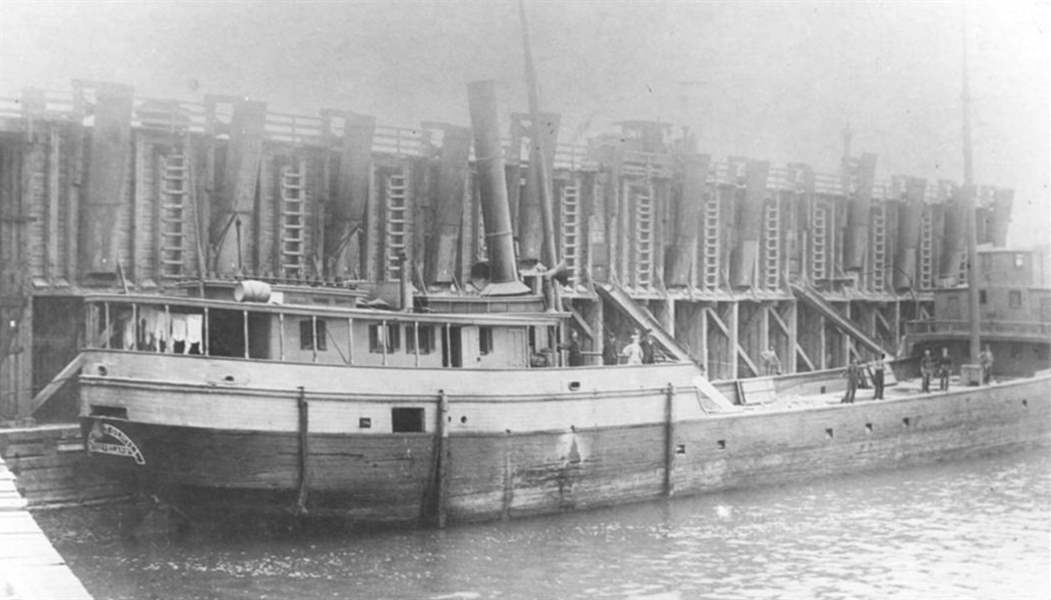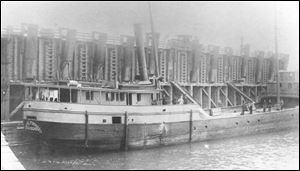
Long-sought ship that sank more than 100 years ago found in Lake Erie
3/15/2018
Shipwreck hunters sponsored by the National Museum of the Great Lakes have announced discovery off Lorain of a steam-powered barge that sank during a storm in 1899, killing at least eight people on board. The Margaret Olwill was hauling 900 tons of limestone from Kelleys Island to Cleveland when it wrecked.
A shipwreck hunter sponsored by the National Museum of the Great Lakes in Toledo has found the long-sought steam barge Margaret Olwill, which sank in Lake Erie off Lorain during a storm in 1899, the museum announced Thursday.
At least eight people died in the shipwreck, with a possible ninth being an unidentified deckhand, and newspapers at the time described survivors having to cling to floating wreckage for hours in the storm-tossed lake before their rescues.

Shipwreck hunters sponsored by the National Museum of the Great Lakes have announced discovery off Lorain of a steam-powered barge that sank during a storm in 1899, killing at least eight people on board. The Margaret Olwill was hauling 900 tons of limestone from Kelleys Island to Cleveland when it wrecked.
The vessel is believed to have had 13 people aboard and was carrying 900 tons of limestone loaded at Kelleys Island and destined for Cleveland when it foundered.
“The loss of the Olwill was particularly tragic because not only did the captain and his wife perish, but their son, a friend of the family, and other relatives also died as a result of what appeared to be a family trip on the commercial vessel,” the museum said in its statement announcing the find by a member of the Cleveland Underwater Explorers.
Also reported were the discoveries of two other shipwrecks in the area that have yet to be identified.
Those two wrecks, both believed to be sailing ships, were found in July, 2016, while the wreck confirmed to be the Olwill was first located July 26, 2017. The Olwill’s identification was confirmed the following month when divers located its steam-powered engine, which matched the vessel’s recorded description.
Rob Ruetschle, the CLUE-affiliated shipwreck hunter who found the Olwill, said the extent of information available about the Olwill’s sinking made it an appealing search target.
“It was a major disaster back in 1899 when it sank,” he said, describing Lake Erie’s waters off Lorain and Cleveland as “a major thoroughfare for goods and services” during that era.
Mr. Ruetschle said he thought he had located the Olwill wreck back in 1989, but had been busy enough with other projects for many years thereafter that he never confirmed it.

When he finally went back to the location he had logged, higher-resolution “side-scanning” sonar revealed that what he previously thought was a shipwreck was a heap of rocks with a sunken tree trunk nearby.
So he went back to looking for the Olwill, mapping out its likely location using historical records and searching an estimated 60 square miles of Lake Erie before finding it.
“I dove in the night I found it,” Mr. Ruetschle said.
“That’s just the nature of how it is sometimes,” CLUE member David VanZandt said: a sought-after wreck might be found right away, or it might take many days of painstaking searching before it is located.
Shipwreck divers must be especially careful in Lake Erie because of poor visibility and hazards that often include old fishing nets that can become snagged on the sometimes jagged wreckage.
Mr. Ruetschle and Mr. VanZandt both participated in the later dive that confirmed its identity, “and sometime in the next several years we’ll do a detailed archaeological workup,” Mr. Ruetschle said.
It could be several years, Mr. Ruetschle explained, because that requires a large team of divers who need to coordinate their schedules and then be graced with suitable weather.
Mr. Ruetschle himself now lives in Santa Monica, Calif., but maintains a second home in northeast Ohio and spends about three months each year searching for shipwrecks and surveying the ones that have been found.
By agreement, CLUE and the museum do not release the precise locations of newly found shipwrecks until formal surveys can be conducted, “in order to protect the submerged cultural site,” the museum said.
Previous shipwrecks located by CLUE with Great Lakes museum financing include that of the tanker barge Argo, which sank in 1937 with a petroleum cargo on board and was located in 2016 with most of that hazardous material still on board. The federal government spent about $6 million to recover the remaining petroleum.
Contact David Patch at dpatch@theblade.com or 419-724-6094.